
The Honourable Society of the Middle Temple, commonly known simply as Middle Temple, is one of the four Inns of Court exclusively entitled to call their members to the English Bar as barristers, the others being the Inner Temple, Gray's Inn and Lincoln's Inn. It is located in the wider Temple area of London, near the Royal Courts of Justice, and within the City of London. As a liberty, it functions largely as an independent local government authority.

Fleet Street is a major street mostly in the City of London. It runs west to east from Temple Bar at the boundary with the City of Westminster to Ludgate Circus at the site of the London Wall and the River Fleet from which the street was named.
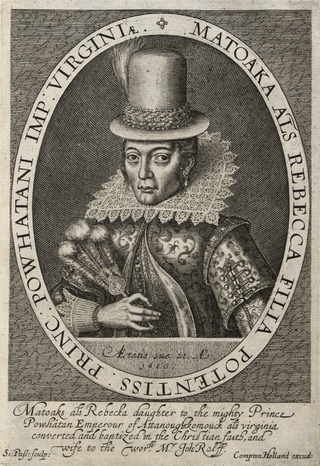
Pocahontas was a Native American woman, belonging to the Powhatan people, notable for her association with the colonial settlement at Jamestown, Virginia. She was the daughter of Powhatan, the paramount chief of a network of tributary tribes in the Tsenacommacah, encompassing the Tidewater region of Virginia.

Ludgate Hill is a street and surrounding area, on a small hill in the City of London. The street passes through the former site of Ludgate, a city gate that was demolished – along with a gaol attached to it – in 1760.

The Theatre was an Elizabethan playhouse in Shoreditch, just outside the City of London. It was the first permanent theatre ever built in England. It was built in 1576 after the Red Lion, and the first successful one. Built by actor-manager James Burbage, near the family home in Holywell Street, The Theatre is considered the first theatre built in London for the sole purpose of theatrical productions. The Theatre's history includes a number of important acting troupes including the Lord Chamberlain's Men, which employed Shakespeare as actor and playwright. After a dispute with the landlord, the theatre was dismantled and the timbers used in the construction of the Globe Theatre on Bankside.

John Cassell was an English publisher, printer, writer and editor, who founded the firm Cassell & Co, famous for its educational books and periodicals, and which pioneered the serial publication of novels. He was also a well-known tea and coffee merchant and a general business entrepreneur. A fervent Christian, he campaigned throughout his life for the temperance movement in Britain, and for the reduction of taxes on publishing. He was a social reformer who recognised the importance of education in improving the life of the working class, and whose many publications, both magazines and books, brought learning and culture to the masses.
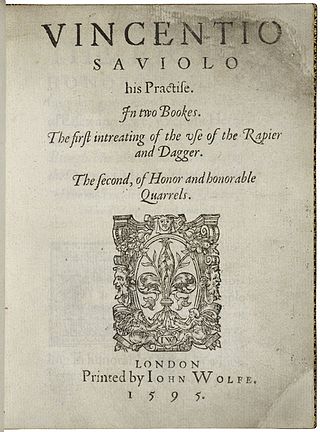
Fencing master Vincentio Saviolo, though Italian born and raised, authored one of the first books on fencing to be available in the English language.

The Great North Road was the main highway between England and Scotland from medieval times until the 20th century. It became a coaching route used by mail coaches travelling between London, York and Edinburgh. The modern A1 mainly parallels the route of the Great North Road. Coaching inns, many of which survive, were staging posts providing accommodation, stabling for horses and replacement mounts. Nowadays virtually no surviving coaching inns can be seen while driving on the A1, because the modern route bypasses the towns in which the inns are found.

The Dorset Garden Theatre in London, built in 1671, was in its early years also known as the Duke of York's Theatre, or the Duke's Theatre. In 1685, King Charles II died and his brother, the Duke of York, was crowned as James II. When the Duke became King, the theatre became the Queen's Theatre in 1685, referring to James' second wife, Mary of Modena. The name remained when William III and Mary II came to the throne in 1689.
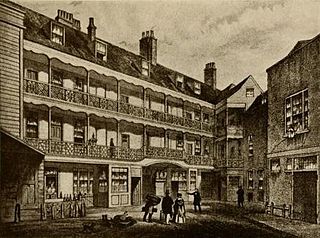
In the historical era of English Renaissance drama, an Inn-yard theatre or Inn-theatre was a common inn with an inner courtyard with balconies that provided a venue for the presentation of stage plays.
Cassell & Co is a British book publishing house, founded in 1848 by John Cassell (1817–1865), which became in the 1890s an international publishing group company.

Charles Dickens's works are especially associated with London, which is the setting for many of his novels. These works do not just use London as a backdrop but are about the city and its character.

Henry Northey Hooper was a preeminent 19th-century American manufacturer and merchant of decorative lighting, Civil War artillery, and bells and chimes. He was a Boston politician and foundry owner and in his firm he cast the first life-size bronze statue in the United States.

Lancelot Baugh Allen was Master of the College of God's Gift in Dulwich from 1811 to 1820.
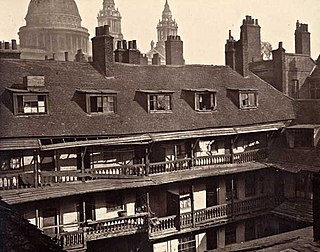
The Society for Photographing Relics of Old London was founded in 1875 in London, England, initially with the purpose of recording the Oxford Arms, a traditional galleried public house on Warwick Lane that was to be demolished as part of the redevelopment of the Old Bailey.
James William Benson was an English scientific instrument maker, gold/silversmith, and watchmaker.
John Collis Snaith was an English first-class cricketer active 1900 who played for Nottinghamshire. He was born in Nottingham; died in Hampstead. He was also a novelist, writing as J. C. Snaith, and played in the Authors Cricket Club alongside fellow authors A. A. Milne and P. G. Wodehouse among others.
This is a list of the etymology of street names in the City of London.
This is a list of the etymology of street names in the London district of Southwark. The area has no formally defined boundaries – those utilised here are: the river Thames to the north, Tower Bridge Road to the east, Bricklayers Arms/New Kent Road/Elephant and Castle to the south, and London Road/St George's Circus/Blackfriars Road to the west.
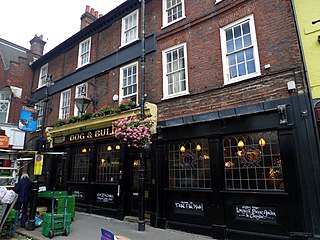
The Dog & Bull is a public house in Croydon, England. It is a Grade II Listed, 18th-century building with a 19th-century frontage in Surrey Street, on the site of a previous 12th- or 13th-century inn called The Bell.


















